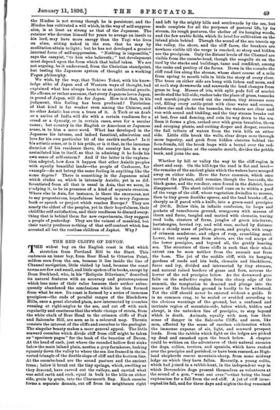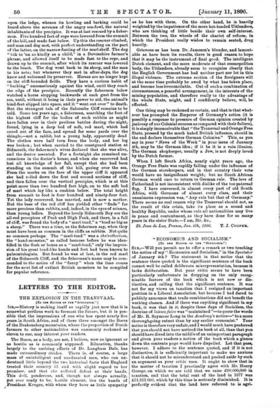THE RED CLIFFS OF DEVON.
THE widest bay on the English coast is that which stretches from Portland Bill to the Start. This embraces an inner bay, from Beer Head to Otterton Point, seldom seen from the sea, because it lies inside the line of Channel navigation, little visited by land, because the coast towns are few and small, and little spoken of in books, except by Dean Buckland, who, in his "Reliquia3 Diluvianm," described its natural features with an accuracy and picturesqueness which lose none of their value because their author subse- quently abandoned the conclusions which he then formed from what he saw. Its coast is formed by a series of immense precipices—the ends of parallel ranges of the Blackdown Hills, once a great elevated plain, now intersected by coombes running at right-angles to the sea, and cut off with such regularity and exactness that the whole change of strata, from the white chalk of Beer Head to the crimson cliffs of Peak and Salcombe Hill, are seen as in a coloured map. Therein consists the interest of the cliffs and coombes to the geologist The singular beauty makes a more general appeal. The little seaward coombes which divide cliff from cliff might be taken as " specimen pages " for the book of the beauties of Devon. At the head of each, just where the rounded hollow first sinks below the main inland plain, nestles a grey farmhouse, looking equarely down the valley to where the sea lies framed in the in- verted triangle of the double slope of cliff and the horizon line. At the coombe-head are the sound pasture and the ancient trees ; below it break out the tiny springs, which, swelling as they descend, have carved out the valleys, and carried what was solid earth and rock, equal in bulk to the hills on either side, grain by grain, into the Charmouth Bay. Each coombe forms a separate domain, cut off from its neighbours right
and left by the mighty hills and southwards by the sea, but made complete for all the purposes of pastoral life, by its stream, its rough pastures, the shelter of its hanging woods, and the few arable fields, which lie level for cultivation on the inland plain behind Though the sound of the sea travels up the valley, the shore, and the cliff faces, the breakers are nowhere visible till the verge is reached, so steep and hidden are the precipices. Only the distant levels of the Channel are visible from the coombe-head, though the seagulls sit on the turf by the stacks and buildings, tame and confident, among the rooks and poultry of the farms. Down in the coombe the cliff road lies along the stream, whose short course of a mile from spring to mouth tells in little the story of every river. The trees on either side are hung with lichen and moss, and at each step downwards and seawards the land changes from grass to bog. Masses of iris, with split pods full of scarlet seeds stud the hill-side, rushes take the place of grass, tussocks and marsh-jungle crowd out the rushes, tiny streams ooze out, filling every cattle-print with clear water and creases, alders rise and choke the tussocks, the waters are clear and run with sound and tinkling, and the tiny stream breaks out at last, free and dancing, and cuts its way down to the sea. Soon it forms a glen, arched over with green brambles, thorn and creeping plants, and cutting deeper and deeper, receives the fall tribute of waters from the twin hills on either side. Little rills break the walls, clear drops ooze through moss tapestry, and gush from hidden cisterns behind the fern-fronds, till the brook leaps with a bound over the red- sandstone precipice at the coombe mouth, divides the pebble bank, and joins the sea.
Whether by hill or valley the way to the cliff-region is short and easy. On the hill-tops the road is flat and level— the remains of the ancient plain which the waters have scooped away on either side. Here the furze common, which once covered the plateau, still remains, though the buzzards, the black-game, and the roe-deer, once found in the district, have disappeared. The short rabbit-turf runs on to within a yard of the verge of the cliff, where vegetation dwindles to mosses, then to tiny green dustlike spores, and the land breaks off, as sharply as if pared with a knife, into a green-sand precipice of 200 ft. Below this, in infinite confusion, lie loops and pockets of tumultuous ground, overgrown with masses of thorn and furze, tangled and matted with clematis, waving reed beds, clusters of ferns, jungles of green iris-leaves, hartstongue, berried ivy, and wild rose, melted by distance into a cloudy mass of yellow, green, and purple, with crags of crimson sandstone, and edges of rosy, crumbling marl. Lower, but rarely seen from above, are the red scarps of the lower precipice, and beyond all, the gently heaving sea. The structure of these cliffs is such that their whole extent can be seen neither from the summit nor from the base. The jut of the middle cliff, with its hanging gardens of reeds and iris beds, clematis and blackthorn, furze and ivy, divided and intersected by tiny streams, and natural raised borders of grass and fern, screens the horror of the red precipice below. As the downward gaze falls on the seductive region from the sharp edge of the summit, the temptation to descend and plunge into the mazes of the forbidden ground is hardly to be withstood. Yet the cliff should never be entered without a guide. It is no common crag, to be scaled or avoided according to the obvious warnings of the ground, but a confused and intricate region of mountain-side, below which, hidden and abrupt, is the unbroken line of precipice, to step beyond which is death. Animals, equally with men, lose their sense of danger in the Salcombe Cliffs, and seem, like men, affected by the sense of careless exhilaration which the immense expanse of air, light, and seaward prospect lends. Even the rabbits which fight on the ledges are picked up dead and smashed upon the beach below. A chapter could be written on the adventures of their natural enemies the dogs, collies, terriers, and spaniels, which have rushed over the precipice and perished, or have been rescued, as High- land shepherds rescue mountain-sheep, from some midway ledge on which they have fallen. Recently, a young collie, which had joined in a rabbit-hunt, in the independent way in which Devonshire dogs present themselves as volunteers at the sound of a gun, " went out over,"—that being the local euphemism for a fall from the red cliff. A jut of cliff inter- cepted its fall, and for three days and nights the dog remained
upon the ledge, whence its howling and barking could be heard above the screams of the angry sea-fowl, the natural inhabitants of the precipice. It was at last rescued by a fisher. man. Five hundred feet of rope were lowered from the summit of the hill, and made fast below. Up this the rescuer climbed, and man and dog met, with perfect understanding on the part of the latter, on the narrow footing of the marl shelf. The dog " tiik to 'on zo kindly as a child," in a Devonshire farmer's phrase, and allowed itself to be made fast to the rope, and drawn up to the summit, after which its rescuer was lowered to the beach. The dog went back to its sheep, and the man to his nets; but whenever they met in after-days, the dog knew and welcomed its preserver. Horses are no longer kept on the cliff-bounded fields. They have a curious habit of " backing " unconsciously against the wind, until they reach the edge of the precipice. Recently the fishermen below watched a. horse stepping backwards at each gust from the sea, until, without it being in their power to aid, the animal's hind-feet slipped into space, and it "went out over" to death. But the strangest tale of the Salcombe Cliff remains to be told. Some ten years ago, a fisherman, searching the foot of the highest cliff for the bodies of such rabbits as might have fallen over in their perilous battles during the night, found, lying in a deep bed of soft, red marl, which had oozed out of the face, and spread for some yards over the shingle,—not a rabbit, but a young lady, apparently dead The clothes were half torn from the body, and her leg was broken ; but when carried to the coastguard station at Sidmouth, the fishermen's wives declared that she was alive, and the doctor assented. For a fortnight she remained un- conscious in the doctor's house, and when she recovered had lost all knowledge of her fall, except that she had been standing on the summit of the hill, gazing over the sea. From the marks on the face of the upper cliff it appeared she had rolled down the first and second sections of cliff, and then fallen over the vertical precipice, which is at this point more than two hundred feet high, on to the soft bed of marl which lay like a cushion below. The total height from summit to foot is four hundred and ninety-four feet. Yet the lady recovered, has married, and is now a mother. But the base of the red cliff has yielded other " finds " far more precious than rabbits, and, indeed, in the eyes of science, than young ladies. Beyond the lovely Sidmouth Bay are the all-red precipices of Peak and High Peak, and there, in a fall of cliff, was found the body of a " marl-toad," a "toad so big as a sheep." There was a time, so the fishermen say, when they must have been as common in the cliffs as rabbits. Not quite so common perhaps. The " marl-toad " was a cheirotheriant, the "hand-monster," so called because before he was iden- tified in the flesh or bones as a "marl-toad," only the impres- sion of his great toad-like hands and feet had been known to palanntologists. But found he was at last, in the red marl of the Sidmouth Cliff, and the fisherman's name may be com- mended to the notice of the " fancy " when the time comes for the next list of extinct British monsters to be compiled for popular reference.



































 Previous page
Previous page